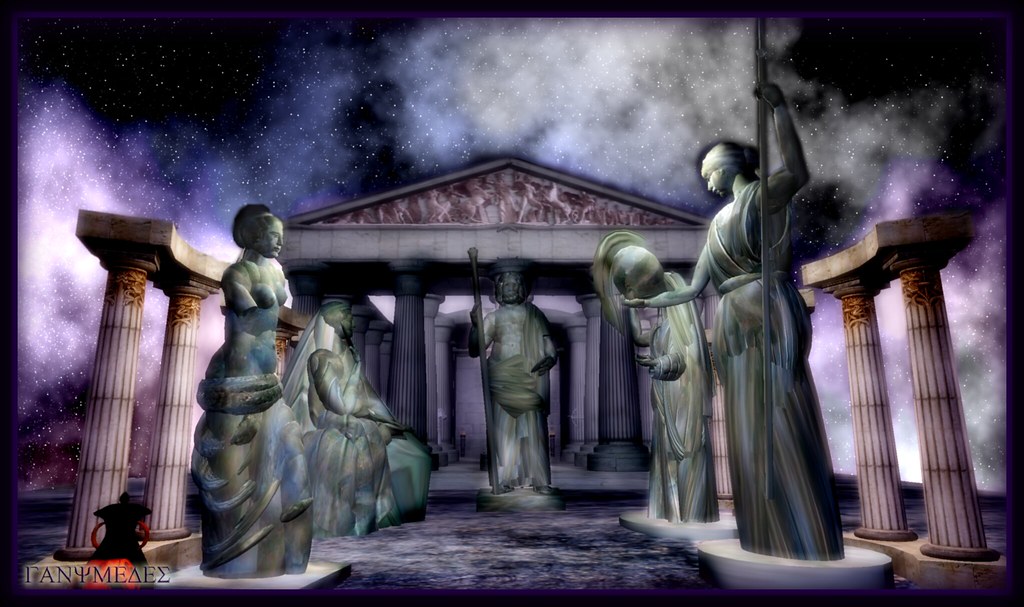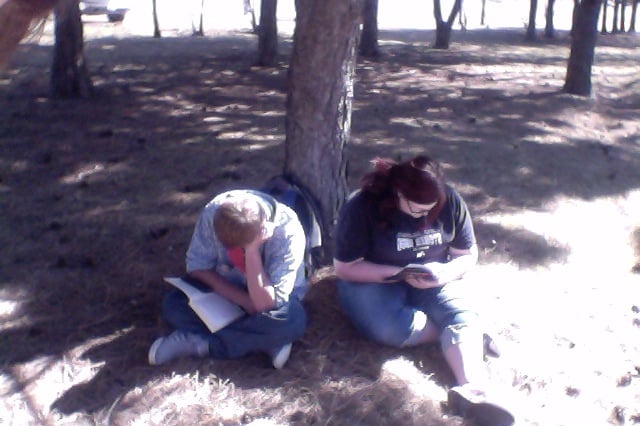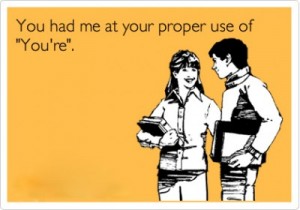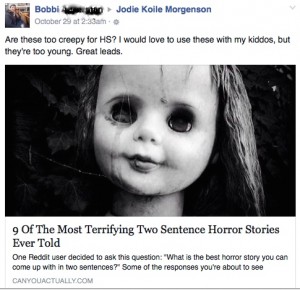One time I heard one of my third grade teachers telling one of my classmates that he was loquacious. (This was the same teacher who threw her giant textbook as hard as she could on the ground in response to her frustration with this same student, so I tended to pay attention to all of their interactions. It was one of the juiciest teacher-student relationships I had ever witnessed.) I didn’t know what loquacious meant, and I was certain it was something horrible so I looked it up. As it turns out, it means “talkative.” Not so horrible, and I remember thinking, “Well, I am NOT loquacious (in school).” I think of that teacher and that classmate every time I happen upon that word, which up until very recently was not a frequent occurrence. However, all of that changed this semester, when the word loquacious showed up as a vocabulary word for my 10th graders. I guess this is one example of why you SHOULD use big words with your own children (and students). Most students don’t want to be left in the dust, so if they don’t understand what a word means, they will ask you, or even the quiet ones (like me) will find out meaning on their own. Even if they don’t immediately, at least they will have a layer of context to work with the next time they hear the word used again.
ELA
The Relateable Prince Escalus
During 6th hour today, I read the part of Prince Escalus in scene 1 Act I of William Shakespeare’s Romeo and Juliet and I may have gotten into it a little too much.
It’s just that I relate to Prince E. He’s fed up with the shenanigans of his people, but when he speaks, he has trouble getting them to take him seriously, or even listen in the first place. Even with the threat of severe punishment hanging over the city, they are so wrapped up in their own affairs, they cannot be bothered to stop what they are doing to hear what he has to say. When he hears of yet another brawl stemming from the ridiculous ancient Veronian grudge, he enters the scene in a fury.
He addresses them, “Rebellious subjects!” (Everyone keeps fighting.) “Enemies to peace!” (A chicken flies past his head.) “Profaners of this neighbor-stained steel–!” (A friar gets stabbed in the eye and is wheeled out in an apple cart.) “Will they not hear?”
I mean what teacher CAN’T relate to Prince E? Maybe my students aren’t brawling in the aisles of the classroom, and so far I’ve never had a live chicken running around during class, and the consequences I lay out are nowhere near as serious as the prince’s, but we have our moments when I want to start class and everyone else in the room has other concerns. That’s normal. Students have priorities. Teachers have priorities. Those priorities don’t always match.
As the day went on, my Prince Escalus performance became more and more passionate. By 6th period, I was really feeling it. I got louder and louder. And, now my vocal cords feel broken, but I had some fun playing the role of Prince Escalus today.
Instagram of the God/desses (a lesson plan, with handouts)
 Ganymedes Costagravas via Compfight
Ganymedes Costagravas via Compfight
To prep for our upcoming freshman English Odyssey unit, we are researching the gods, goddesses, and some other mythological friends. In order to avoid the boring Powerpoint/poster board format of the days of yore, my colleagues and I tapped into popular culture and asking the students to present their research in the form of a social media profile. I went the Instagram route.
My intention was to let them choose between Instagram, Facebook, or Twitter, but as the day turned into night and the night turned into morning as I worked on the Instagram template, I decided to go to bed and so #Insta it was. (I toyed with the idea of a Snapchat template, but I just couldn’t pull that one out this time. By the next time I teach The Odyssey, there will be some other social media outlet for which I will need to devise a template.) The students had the option of printing off their template and drawing “photos” by hand, or creating a digital document using Pages.
I am an activist teacher.
It’s amazing how a 20-minute conversation can change the way you view yourself. Just like that, I became an activist teacher. 20 minutes! I have never thought of teaching as a political act prior to today, and I feel naive admitting this, because now it seems so obvious, but in the interest of transparency and honesty I’m sharing this with you, dear reader. I’ve always considered myself a little bit of a quiet system bucker, even in my earliest days of teaching, but the word “activist” wasn’t on my radar in relation to ME.
Today the class I am in went and visited another class that has been studying teacher activism. We rotated through two of three stations and in one of the sessions they asked us to think of a time when we opposed a policy, curricular choice, or something else in our school and what step we took to oppose it. It was very easy for me (and my colleagues) to come up with several examples. The older I get the more squeaky of a wheel I become. I cannot stand idly by and allow things that are not good for our students to happen.
When I think about the educators I admire most, (from those I’ve studied –John Dewey, Paulo Friere, Ira Shor, bell hooks, Jean Piaget–to those I’ve grown to admire more recently–Rick Wormeli, Ken O’Connor, Sir Ken Robinson, Diane Ravitch, many of my Twitter friends–and those I know personally–you know who you are …) I have come to realize that one of the reasons I am drawn to them is because they stand up for what is right for students.
Every time I make a decision in the interest of my students, even if it goes against the status quo, I am an activist. Every time I post something on my blog that aims to change the way someone thinks, I am an activist. Each time I defend public education to the naysayers, I am an activist. Each time I stand up for my students, I am an activist. Acknowledging this makes me feel brave.
I might be taking small steps in the world of activism compared to other more public figures in education or even some of you that I know more personally, but as my confidence builds, so shall my activism, especially now that I know I am an activist.
#phsCONlit Assignment: Response to Stitches, a [Graphic] Memoir, by David Small
Now that you’ve made (at least) one pass through Stitches, A Memoir, by David Small, your final assignment is to respond to the following questions in the form of an essay or a blog post. There are no length requirements, but your responses should fully explore the questions posed. Go beyond a surface-level response. Keep in mind that this your final for this unit, so you should handle it in a way that reflects your careful consideration.
Mama had her little cough … <KNH!> once or twice, some quiet sobbing, out of sight … or the slamming of kitchen cupboard doors. <WHAP!> <WHAP!> <WHAP!> That was her language.
For example–if you are working on responding to question 1, if you just tell me that you thought reading the book was “fine”, that it’s similar to reading a traditional memoir because “it tells a story”, and that it is different from reading a traditional books because “there are pictures”–that’s not a well-developed response. If you give me specific examples from Stitches to illustrate why you did or didn’t like it; you describe strategies and/or methods that work for reading both types of books; and you give specific examples of how the process of reading a graphic novel and a traditional book are different, you’ll be golden. The more specific you get, the better.
David: I … she … she’s … craze- y!
<creak> <creak>
Mama: Listen to me: I don’t ever want to hear you use that word again! Do you hear me? NEVER!
Before beginning your responses, you should consider engaging in a second read-through to “catch” things you missed on your first read. As I have mentioned before, I have read this book in the neighborhood of 10-15 times and I catch something new every time!
1. What did you think about reading a graphic memoir? How is it similar to reading a traditional memoir? How is it different?
2. How did the elements of the graphic novel contribute to your understanding of the story? For example, think of the graphic weight of the lines, and the frames; the surreal vs. real (How can you tell the difference?); changes in drawing styles; foreground, midground, and background; speech bubbles, thought bubbles, and special effects lettering; the facial expression and body language of the characters. Get specific. Give me specific examples from the book. Use page numbers and descriptions to explain your response.
And that is not all! What about the literature he’s been reading? Talk about that. All those books in his room. All that SMUT!
Before you answer the next questions, do the following:
Read this article —> New York Times: Finding a Voice in a Graphic Memoir.
You already watched this video —
— but you can watch it again, if need be.
3. How does reading this article and watching the video contribute to your understanding of Stitches, A Memoir? Was there anything that surprised you about either of them? (Be sure to explain why.)
4. Do you believe that graphic novels/memoirs should be included in an academic setting, like this Contemporary Literature and Writing class, or other classes? Why or why not?
You’ve been living in a world full of nonsense, David. No one had been telling you the truth about anything. But I’m going to tell you the truth. Are you ready?
Respond to the above four questions in a typed, 12-point, double-spaced essay OR post it as a blog entry. Your choice. Email me no matter what–either to send me your essays as a PDF or send me an email stating something to the effect of “I posted my essay as a blog post,” no later than Tuesday, April 21, 2015, by 11:59 PM.
I’ll be assessing your writing on…
CONTENT (65%): Are your responses fully developed, thoughtful response? Do you go beyond the surface of what the question is asking? Did you use specific examples? Were your responses accurate?
DICTION (10%): Do the word choices you made convey the ideas you are trying to express? Is there a way to say what you want to say more clearly?
CONVENTIONS (25%): Did you edit? Did you follow the rules of Standard English? Did you use paragraphs? Did you use 12-pt font? Did you double-space?
(All quotes in bold above are take from Stitches, a Memoir, by David Small.)
On The Danger of Books That Have Been Made Into Movies (and Potential Flim-Flammery)
The title of this blog post is a bit alarmist, especially since I was specifically speaking from an academic standpoint. Some teachers fear that students who have been assigned to read books that have been made into movies will not read and will just watch the movies instead, presumably working under the assumption that the movie is exactly the same as the book. Alarmist indeed, especially since I don’t think there is any danger in this situation, even academically speaking.
If your student hasn’t read the book, you will know. After all, you can’t flim-flam a flim-flammer … eh? I mean we were high-schoolers once. We went to college! We know all about tomfoolery, malarkey, funny business, and shenanigans. (I would’ve used another better-known saying at the beginning of this paragraph, but I like to keep this blog family-friendly … ish.) If your student hasn’t read the book, but watched the movie (or for that matter listened attentively during lectures or class discussions), s/he might be able to answer very basic content questions, but it will be nearly impossible for him/her to analyze or evaluate without being vague. This is when you can pull out your questions that pertain to the movie but not the book or vice versa … and BAM! you know you have a flim-flammer on your hands. Proceed according to your classroom policies regarding students who don’t do their work (which hopefully includes trying to get to the bottom of WHY the student is avoiding the work). Will there be the rare exception of the student who is so skilled in the art of bull-skooting that s/he will be able to dazzle her/his way through an assessment over a book s/he has not legitimately read? YES, but you don’t have supernatural powers, so there is nothing you can do about it, so let it go. As long as the student isn’t doing something to hurt her/his classmates, school property or you … for good gravy’s sake, let it go.
CONFESSION: I used to be one of those teachers who lived in fear of students poppycocking their way through a literary unit armed with only their cinematic knowledge of a piece of literature. What if they don’t read? What if they lie to me? What if they trick meeeee? What will my colleagues think of me? What will my principal think of me? Why am I so worried about me? Me? Me? Meeee? Why am I worrying about things that haven’t even happened yet and might not ever happen? Why don’t I trust kids? Why am I such a control freak? The older I get, the more I realize that, except for what I do and feel, I cannot control much else, which allows me to live in fear no more. A conversation I overheard during a lit circle discussion a day or so ago helped to solidify this and I will tell you about it, but first, a digression:
In my Contemporary Literature class, one of my goals (which is-dare I admit this publicly?–NOT ATTACHED to a state standard—GASPPPPpppp!) is to take each of my students’ stance on reading and move it closer to LOVE.
Allow me to expound visually …

Where do you fall on the Reading (the feels) Spectrum? I’m just west of considering reading as marriage material.
In other words, no matter where the a student is on the Reading (the feels) Spectrum, I want that student to be closer to LOVE when s/he walks out of my class at the end of the semester. Most kids walk into my class with a basic MERPitude toward reading. They don’t outright hate it, but it’s not something they crave. Some kids walk in somewhere between MERP and HATE. Even fewer walk in somewhere between MERP and LOVE. It is a rarity that a student is already in LOVE with reading when they walk in, but it does happen. In fact, every so often I have a student take Contemporary Literature because s/he wants to, even though s/he is already enrolled in another English class and doesn’t need the extra credit to graduate. When that happens it is a true compliment to English Language Arts–probably one of the highest.
In Contemporary Literature, (which originally was created for students who did not plan to attend a four-year college, but now has been overflowing with students of every post-high school intention imaginable … !!!) I use the following things to help move student closer to LOVE:
A. high-interest books: I do not pay attention to reading level or text-complexity. I look for well-written, interesting, books with relatable characters and topics that affect modern students. I don’t give a flying fig if it appears on some elite College Board or ACT list. I don’t care if scholars think it’s trashy, or simple, or cheesy. If it hooks a reluctant reader’s interest, I’ll take it.
B. self and group regulated activities: –like literary circles, for example. Activities like lit circles gives the students choice and independence–something that EVERYONE needs to thrive, whether they are 2 or 100. These are also elements that are too often left out of the classroom, sadly.
C. alternative texts: We dive into graphic novels, science fiction, articles from the web, podcasts, and movies. YES: Movies ARE a -visual- text.
And now back to my original topic … Sometimes books inspire students to watch movies. On the other hand, sometimes movies are the gateway drug to books. Yes indeedy: Movies can lead students to books! Sometimes a kid likes a movie so much that s/he decides to read the book. And, sometimes a kid is assigned a book that has been made into a movie, and even though the movie isn’t exactly like the book, it still helps the kid understand the book–either before the student reads or retroactively. Those are positive things!
Personally, I prefer to read a book THEN watch a movie. However, other people have different preferences. Just because that’s the way I like to do it DOESN’T MEAN EVERYONE HAS TO LIKE IT THAT WAY. (That’s hard for some teachers to grasp, I’ve noticed.) For me, once I’ve seen a movie, it’s hard for me to NOT picture the actor who played each character as I read, and I don’t like that, but not everyone has those issues. They are either able to block the actors’ images from their minds or they enjoy having a visual upon which to rest the mind’s eye.
If you choose a book to teach (or allow students to choose a book to read) that has been made into a movie, will you have a percentage of kids who will watch the movie in lieu of reading? ALWAYS. Just like you will always have a percentage of kids who “replace” reading with Wikipedia or Sparknotes or LitCharts or the next newfandangled thang that comes along under the guise of helping people understand literature but which actually serves as a means for kids (and adults) to cheat on content-level tests (and book club meetings). (In fairness to the aforementioned entities, I will say that when used with integrity, they do serve as a resource for helping people understand literature–at a surface level.) That being said, if a kid is able to pass an assessment without reading the book, are you asking the right questions? (That is for another blog post, methinks.)
Now back to that conversation I mentioned earlier in the post. During lit circles the other day, I overheard students discussion the book, The Fault In Our Stars by John Green, which is not only a popular book, but also a popular movie. The group members had all seen the movie. They were comparing the book to the movie and making note of all of the differences. They were also evaluating the movie based on the book–what they liked about the book and what they thought the movie did better. They were also qualifying WHY they felt that way. This was a grown-up conversation, and they were doing this without my guidance and without micro-management of any sort. The lit circle provides a flexible structure for the students. They build outward from that structure. It is always an honor to lead a class in discussion, but it is an even more rewarding to listen to young people do it on their own. And guess what? They held each other accountable for reading. Based on my experience, students are more motivated to be prepared when they know their peers will be upset with them than they are when they just know that the teacher might be upset. And it is one thing to attempt to bamboozle a teacher. It is another thing to attempt to hornswoggle a group of your peers. They will call you out–publicly. And they will determine whether or not you read or just watched the movie and said you read. They will ask the trick questions outright!
The movie version of The Fault in Our Stars served as another point of dialogue for the students. It did not detract from the conversation. It did not demotivate them. They still read the book. They held one another responsible. They got into higher levels of thinking (analysis, evaluation) BECAUSE they watched the movie AND read the book.
Outside of lit circles, there will be kids whose interest is sparked enough by a movie that they will read the books that inspired the movies … and they might even like reading those books … maybe even a little bit more than they enjoyed their last reading experiences. As a result, they move a little closer to LOVE!
That is a good thing. That is what teaching is all about.
Serial Podcast Dialogue for Episodes 1-6 #phsCONlit
NOTE: If you are here from somewhere other than Mrs. Morgenson’s Contemporary Literature and Writing class, know that the comments after this post have spoilers for Episodes 1-6 of the Serial podcast.
Hello #phsCONlit students,
This blog post is for you. Here is where we will have a dialogue about the Season 1 Serial Podcast. By the time you post any ideas here, you should have listened to at least the first SIX episodes of the podcast AND completed the examination of evidence presented in Episode Six.
At this point, what is your stance on this case? Was Adnan faultily convicted or is he where he needs to be (in jail)? (Explain your position.)
Remember that in the United States, in a court of law, to be found guilty a jury must find the accused guilty beyond a reasonable doubt. In other words, they are not supposed to convict based on a hunch, their feelings, their own experiences or anything else other than the facts presented at trial. (Does this always happen? No. Of course not. Any time human beings are involved in decision-making, there is room for personal judgement/baggage/opinions/experience to influence a decision. That’s why there are 12 people assigned to a jury. The hope is that they will balance each other out somehow. That’s also why there is a jury selection process–so anyone with obvious biases will be “weeded out” of the jury pool.) So, when you are answering the above question think about the following options …
- You believe Adnan is probably guilty, but you don’t think there is enough evidence to convict him beyond a reasonable doubt.
- You believe Adnan is guilty, and there is enough evidence to convict him beyond a reasonable doubt.
- You believe that Adnan was involved in Hae’s murder somehow, but he probably didn’t kill her.
- You believe that Adnan is innocent and deserves to be set free.
- Another option that I’m not thinking of right now …?
- Bonus: If you believe Adnan is innocent, who do you think killed Hae?
I also want you to consider how Sarah Koenig presented the evidence. Do you believe she is biased in her reporting, or is she balanced? Do you believe her opinion is evident, or does she have a good “poker face” or in this case, “poker voice”? Does her presentation of the evidence affect your opinion regarding Adnan’s guilt or innocence?
Respond in the comments below BEFORE you read your classmates’ responses.
Once you’ve posted, read through your classmates’ comments and respond to their comments–particularly those you disagree with. (Keep it civil!) Extend one another’s thinking in this matter. Try to convince each other that your stance is the right stance. Work on persuading one another to sway each other to your point of view. If someone legitimately sways your opinion, say so and say why. Everyone needs to interact with other commenters.
ASSIGNMENT:
- Answer the question posed above (before reading your classmates’ comments).
- After you have posted your comment, respond to at least FIVE other commenters with reasons why you agree or disagree with their stances. (The most interesting dialogue most likely will come from the people with whom you disagree.)
- If someone responds to your original comment, you should reply back to that commenter to further extend the dialogue until it comes to a satisfying close.
- Review the section of THIS POST about posting quality comments (scroll down), if you need a refresher on what that entails.
- You will be graded on the quantity of your comments (at least 5), the quality of your comments (see #4, if you need a refresher), and the responsiveness you demonstrate to fellow commenters (including me. I will jump in and play devil’s advocate from time to time, if I see the conversation getting stale).
I am pro-digging for explanations about anti as a preposition.

![]() Photo Credit: Wessex Archaeology via Compfight
Photo Credit: Wessex Archaeology via Compfight
Prior to recently, I have only ever thought of anti as a prefix. However, it recently showed up on a list of “frequently used prepositions” for my AP English and Literature students. One of my students noticed it hanging out in the “A” section of the list and asked, “Is anti really a preposition?” I told her that I hadn’t ever used it as a preposition, but that I would look into it.
We were right in the middle of my model grammar lesson–the one I alluded to in my post about how grammar instruction is a big fat challenge for me–so we carried on with the lesson. The problem was that I couldn’t really think of an example of how I might use anti as a preposition. Call it a brain fart. Call it a knowledge block. Call it a lapse in the thinks. Whatever you want to call it, I couldn’t, at that moment, think of it in those terms. So, I turned to a web search. It didn’t take long to come up with a basic definition and an example sentence for how to use anti. I must sheepishly admit that it was the first entry that popped up in my search.
I sent my students this email at the end of the school day:
One of you asked about the preposition anti … I had never thought of it as a preposition before, so I did some digging. (I didn’t have to dig very far.) I found this via our friend Google –>
preposition: anti
opposed to; against.Example: “I’m anti the abuse of drink and the hassle that it causes.”
To me this seems like an awkward say that “I’m against the abuse of drink and the hassle it causes,” but I suppose some people may use this as a way to add variety to their phrasing.
My student responded later that evening with the following message:
Interesting, thanks for looking into it! However, I am still confused on how is it a preposition. If you take that part of the sentence out, it doesn’t make sense.
I felt like she was right, until I thought about it for a while. (Here is where diagramming MAY have come in handy …) I also realized my explanation was too … first-entry-on-Google-searchish, so I responded with this:
Actually … now that I’ve pondered this a little longer I realized that it actually does (technically) make sense … I’m anti the abuse of drink and the hassle that it causes.
Really the sentence I’m … or I am can stand alone. Technically “anti the abuse …” modifies (describes) what “I am.”
For instance, look at this sentence … I’m under the table.
The subject is I and the verb is am. The prepositional phrase is under the table. It modifies where I am … Does that make sense?
I did research this further after your observation though and it seems that anti is more of a British preposition than an American one … which probably why it sounds weird to us.
My hope is that, henceforward, if you, dear reader, are ever confused about why anti is on a list of frequently used prepositions that this post will pop up on a web search and that you will dig deeply enough to find it.
The Lament (and Plea) of a High School Grammar Teacher
When I was in high school, I diagrammed exactly ZERO sentences. In fact, I didn’t even know what diagramming was until college, when I took a Linguistics class well after declaring secondary language arts as my major. I remember doing grammar worksheets in elementary school, junior high, and high school. I remember learning tricks like FANBOYS (which maybe isn’t even a thing anymore???) and being confused by when to use commas. I also know that until I became an English teacher and researched it on my own, the semicolon was an enigma. (Now it’s my favorite.)
I also remember learning more about grammar in French class than in English class. I, without a doubt, learned more about how to apply grammar to my writing as a school newspaper staffer than I ever did in any English class. Newspaper staff is where I learned how to use a style guide too. Even though it was the AP Style Guide, it still set the foundation for using MLA and APA in college in the sense that it was a place to go when I wasn’t sure about something.
I’ve also sort of been blessed with excellent grammar genetics. I’m a good speller and have a good gut for the rules. Reading was a big deal in my household growing up too, so I’m certain I picked up on the rules of Standard English Grammar because of how much reading I did as a child and young adult. (Thanks for setting that foundation for me, Mom.)
During my language arts methods classes in college, we didn’t learn any techniques for teaching grammar explicitly. We were told that students should learn grammar through their own writing and that we should address grammar issues prescriptively. In other words, when we noticed an ailment, we should offer the student a cure at that time, rather than taking preventative measures, because discrete grammar instruction was supposedly ineffective.
So, it should come as no surprise that I really don’t know the best way to teach grammar. There. I admitted it.
I have some ideas, but I’ve been using the prescriptive method for nearly 15 years now and I’m not convinced it’s the right way to go about it. However, drill and kill doesn’t sit quite right with me either.
It is also less than unexpected that when I seek advice on best practices for teaching grammar from other teachers via social media that I get a whole bunch of cricket chirps in response. I have also done some poking around on the web and there are some good lessons out there … creative, engaging, helpful … but they are few and far between, and random. There isn’t that much stuff out there to help teachers teach grammar (in an engaging way). For example, when you type in “Romeo and Juliet Lesson Plans” in a search engine, something in the neighborhood of six magjillion lesson plans come up and a good number of them are effective. Not so with a search of “high school grammar lesson plans.”
Hear my cry, internet!
How do you approach grammar in your high school English classrooms?
I tried something new in the grammar department today and the lesson will continue tomorrow. (It may bleed into next week for all I know) … and I will document the experiment here.
What I really want to create is a bank of awesomely engaging lessons that teach something that is not usually categorized as “awesome” or “engaging” (in the eyes of most students anyway). If you have an awesomely engaging grammar lesson for high school students, will you share? Please?
Also, if you would, please share this post and respond in the comments below. (Please don’t share this with any crickets though.)
Two-Sentence Horror: A Quick, Fun, Challenging Writing Assignment for High School Students on Halloween

Photo Credit: Brenda Clarke via Compfight
Right before Halloween, one of my sixth grade teachers sent me a post on Facebook leading me to an aggregation of two-sentence horror stories. She still teaches sixth grade and thought that while these stories might be a little too much for sixth-graders, as a high school English teacher, I could have some fun sharing these with my students. And I agree with her. So I did.
I told them how I came to find these stories and some of them commented on how neat it was that I stayed in touch with my sixth grade teacher still and that it was sort of cool and sort of creepy that she would send me a link to such scary stories. After I read through one of them, my drama students insisted that we turn the lights off. With my AP English students, we just went ahead and turned them off from the outset. The reactions to the stories were pretty good in that I think some of them legitimately creeped out some of the students, which was, after all, at least partially, the goal.
The other goals were to practice brevity in writing. How can we deliver a power-packed story with only two sentences? Which word choices will give the most bang for the buck? Which would be more effective-short sentences? long ons? a combo of both? We had an opportunity to analyze some of the sentences’ grammatical structure. Are some of these run-ons? comma splices? long, grammatically correct sentences? We also talked about formula. Was there a trick to making a short horror story work? Was there a pattern that tied all nine stories together? Which stories were the scariest? Why were they scary?
After reading through all nine of the stories, and having a wee discussion comprised of the aforementioned questions and their responses, I gave the students time to compose their own two-sentence stories. Then we shared them aloud in Drama class. (We had other things to do in AP English, so they just submitted them to me to be shared on a another day.) Oh, and I wrote one too! You will see some of the results below.
from Morgan Z.
That creep was still standing by the bus stop the next day. Even after running him over twice the day before, there he was, standing there.
from Hannah C.
He woke up from a nightmare in which a creature was in his bedroom. He drifted off, while staring at two yellow lights outside his window, except they weren’t lights …
from our foreign exchange student from Holland
De donkere nacht is nog maer net begonnen. Er tyn al 10 lyken geuonden …
(If you read Dutch, you are probably really scared right now…)
from Shaylee M.
I walk down the hallway toward the bathroom, only to see a light coming from a crack under the door. I slowly open the door, but I see no one there … until I turn around …
I woke in the middle of the night and heard a girl singing beautifully. I follow her voice to a pond outside, but all I can see is my demonic reflection.
from Jax C.
Marry had a little lamb; it’s fleece was white as snow. Now Mary’s dead and the lamb’s fleece is red as blood.
I couldn’t move as thousands of their little legs crawled up my arms, legs and into my moth. I screamed, waking my self up only to feel the little legs crawling up my neck.
from Sophia V.
He whispered, “Go to sleep.” So I did … forever.
I was walking though the forest as the sun was going down. I saw a tall man with a white face and now all I can give you are signs from my own blood to stay away.
She was only four years old and dressed in white. But she managed to kill me anyway.
from Tanner P.
One day I came home from school and had a hankering for some oreos. When I opened the package, it was empty.
I was walking through the forest, hopelessly lost, and my phone was dead. Then, out of the corner of my eye I spotted him: Shia Labeuof.
It is a tough job being a mortician nowadays. It is getting harder and harder to hide the claw marks inside the coffins.
Supper is the one time that my family all comes together. The only bad part is the main course will not stop screaming.
from Maria B.
Every night, the old woman would say goodnight to her dead husband before crawling into bed. One night, a scratchy, dark voice responded from under her covers, saying, “He’s not here anymore.”
As they lowered my little sister into the ground, i just wanted the funeral to be over. I couldn’t help but wonder if the coffin would supress the screams that were sure to start at any moment.
from Devin N.
It was Halloween night and it was pitch black outside when out of the corner of my eye I saw something on the ground. To my horror it was a person tearing the flesh from a dead rotting corpse and as I looked closer I said, “Mom!?”
And finally … MINE:
“Lullaby, and goodnight,” she sang in her raspy coo to the children. “When did Fluffy learn to sing?” said the boy to his little sister.









